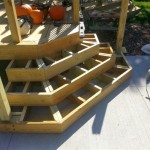How To Make A Stone Patio On Grass
Creating a stone patio directly on grass offers an appealing and cost-effective way to enhance outdoor living spaces. This method, while simpler than installing a patio on a compacted gravel base, requires careful planning and execution to ensure stability and longevity. A well-constructed stone patio on grass provides a functional and aesthetically pleasing area for relaxation, entertainment, and dining.
The successful construction of a stone patio on grass hinges on several key factors, including proper site preparation, appropriate material selection, and meticulous installation techniques. Ignoring these aspects can lead to problems such as uneven settling, weed growth, and water damage, ultimately compromising the patio's structural integrity and visual appeal. This article details the essential steps for creating a durable and attractive stone patio on grass.
Planning and Preparation
The initial stage involves comprehensive planning and preparation. This includes determining the patio's size, shape, and location, as well as assessing the existing grass and soil conditions. The chosen location should ideally be relatively level and well-drained to minimize potential issues later in the installation process.
First, accurately measure and mark the desired patio area using stakes and string. Ensure the outline is precise and reflects the intended design. Consider the surrounding landscape and how the patio will integrate with existing features such as gardens, walkways, and structures. The size of the patio should be proportionate to the available space and adequately accommodate the intended use, whether it's for a small seating area or a larger outdoor dining space.
Next, assess the grass and soil conditions within the marked area. Observe the type of grass, its density, and any signs of disease or pests. Examine the soil composition to determine its drainage capabilities. Sandy soil drains well, while clay soil tends to retain water. This assessment informs the need for soil amendments or drainage improvements. If the area is prone to excessive moisture, consider incorporating drainage solutions such as French drains or adjusting the slope of the patio to facilitate water runoff.
Before commencing excavation, check for any underground utilities such as gas lines, water pipes, or electrical cables. Contact the local utility companies to locate and mark these lines to prevent accidental damage during excavation. This is a crucial step to ensure safety and avoid costly repairs.
Once the planning stage is complete, gather the necessary tools and materials. Essential tools include a shovel, spade, level, tamper, measuring tape, wheelbarrow, and safety glasses. Material requirements will depend on the size and design of the patio but generally include landscape fabric, sand, and the chosen stone for the patio surface. The amount of sand required will depend on the patio size and the desired base depth, typically around 1-2 inches. The type and quantity of stone will depend on the selected material and pattern. Consider purchasing slightly more stone than calculated to account for cuts and potential breakage.
Excavation and Base Preparation
The next step involves excavating the grass and preparing the base for the stone patio. This is a critical phase that directly impacts the patio's stability and longevity. Proper excavation ensures that the patio surface remains level and prevents future settling. Ideally, the depth to excavate depends on the thickness of your chosen stone and the desired finished height of the patio. Usually excavating 4-6 inches is sufficient.
Begin by carefully removing the grass within the marked area using a spade or sod cutter. Aim to remove the grass in large, manageable sections to facilitate disposal or reuse in other areas of the yard. Once the grass is removed, excavate the soil to the predetermined depth. Ensure the excavation is uniform and level, using a level and measuring tape to verify accuracy. Remove any rocks, roots, or debris from the excavated area to create a clean and stable base.
After excavation, compact the soil using a hand tamper or plate compactor. This is particularly important for loose or unstable soil. Compaction increases the soil's density and load-bearing capacity, reducing the risk of settling over time. Compact the soil in layers, typically 2-3 inches at a time, to achieve optimal compaction throughout the excavated area.
Once the soil is compacted, install a layer of landscape fabric over the entire excavated area. Landscape fabric serves as a barrier against weed growth and prevents soil from mixing with the sand base. Overlap the edges of the fabric by several inches to ensure complete coverage. Secure the fabric with landscape staples to prevent it from shifting during subsequent steps.
Following the installation of the landscape fabric, apply a layer of sand over the fabric. The sand layer provides a level and stable base for the stone patio. Spread the sand evenly using a shovel and rake, ensuring a consistent depth of approximately 1-2 inches. Compact the sand using a hand tamper or plate compactor to create a firm and level surface. Use a level to check the sand base and make any necessary adjustments to ensure a perfectly level surface before proceeding to the next step.
Stone Placement and Finishing
The final stage involves the careful placement of the chosen stone and finishing the patio to ensure stability and aesthetic appeal. This requires patience and attention to detail to achieve a professional-looking result. The specific placement technique will depend on the type of stone selected and the desired pattern.
Begin by carefully placing the stones on the prepared sand base. Start from one corner or edge of the patio and work your way across, ensuring each stone is firmly seated and level. Use a rubber mallet to gently tap the stones into place and adjust their position as needed. Maintain consistent spacing between the stones to create a uniform and visually appealing pattern.
If using irregular stones, experiment with different arrangements to find the most aesthetically pleasing and stable configuration. Consider the size, shape, and color of each stone and how it complements the surrounding stones. Cut stones as needed using a wet saw or chisel to fit the desired pattern and fill any gaps. Always wear safety glasses when cutting stone to protect your eyes from debris.
As the stones are placed, check the level of each stone relative to its neighbors. Use a level to identify any stones that are too high or too low and adjust the sand base accordingly. Add or remove sand as needed to achieve a perfectly level surface. Periodically step back to assess the overall appearance of the patio and make any necessary adjustments to ensure a cohesive and balanced design.
Once all the stones are placed, fill the gaps between the stones with polymeric sand or stone dust. Polymeric sand is a specially formulated sand that hardens when wetted, providing stability and preventing weed growth. Stone dust is a fine aggregate that can be used as a traditional alternative to polymeric sand. Sweep the chosen material into the gaps using a broom, ensuring that all the spaces are completely filled.
If using polymeric sand, follow the manufacturer's instructions for activation. Typically, this involves lightly watering the sand to initiate the hardening process. Avoid overwatering, as this can cause the sand to wash away. Allow the polymeric sand to cure completely before using the patio. If using stone dust, lightly water the surface to help settle the dust and prevent it from being easily displaced.
Finally, inspect the completed patio for any loose stones or uneven surfaces. Make any necessary adjustments to ensure that all the stones are firmly seated and level. Clean the patio surface using a broom or hose to remove any remaining sand or debris. Allow the patio to dry completely before placing furniture or using the area for recreation. Regular maintenance, such as sweeping and occasional cleaning, will help preserve the patio's appearance and structural integrity over time.

Diy Patio With Grass Between Pavers And A Fire Pit

Diy Patio With Grass Between Pavers And A Fire Pit

Diy Patio With Grass Between Pavers And A Fire Pit

Diy Paver Artificial Turf Patio

How To Make A Stepping Stone Walkway Lowe S

Diy Patio With Grass Between Pavers And A Fire Pit

Diy Patio With Grass Between Pavers And A Fire Pit Backyard Paver

How To Lay A Stepping Stone Walkway True Value

Simple Paver Stone Walkway In My Own Style

How To Lay A Flagstone Walkway In An Existing Lawn








